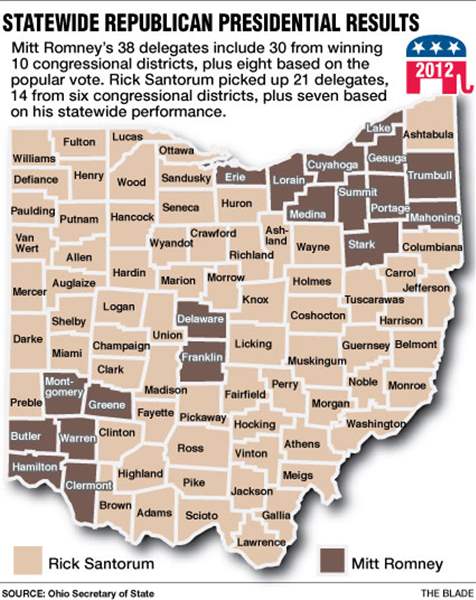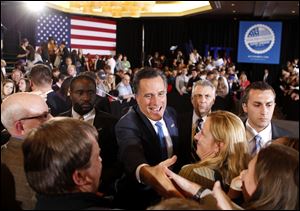
Moderate, urban voters gave Romney his victory in Ohio
Win over Santorum razor-thin
3/8/2012

Republican presidential candidate, former Massachusetts Gov. Mitt Romney, greets supporters at his Super Tuesday primary party in Boston. The unofficial Ohio tally showed that fewer than 11,000 votes separated Romney from his main rival Santorum.
COLUMBUS -- Mitt Romney's narrow Super Tuesday victory in Ohio is not official, but already the fight is on for the all-important Buckeye vote in November.
Vice President Joe Biden will make a stop at an unannounced location in battleground Ohio next week to launch a series of speeches designed to frame the debate ahead, even as the Republican candidates move on to other states to put together the 1,144 delegates needed to seal the Republican nomination for president.
The unofficial Ohio tally showed that fewer than 11,000 votes separated the former Massachusetts governor from his main rival, Rick Santorum. Mr. Romney had 37.9 percent of the vote to the former Pennsylvania senator's 37.1 percent.
In all, Ohio will eventually award 63 of its 66 delegates based on Tuesday's results. At first glance, it appears that Mr. Romney may have earned 38 and Mr. Santorum 21 with four delegates not allocated. The candidates' tallies could change because both include delegates from one congressional district each in which they currently lead in the count, but the races are still considered too close to call.
RELATED CONTENT: March Primary election results
RELATED ARTICLE: Kaptur ads aggressive in beating Kucinich
Mr. Romney's 38 delegates include 30 from winning 10 congressional districts, plus eight delegates based on his statewide popular vote performance.
Mr. Santorum's 21 delegates include 14 from six congressional district wins, plus seven based on his statewide performance. Mr. Santorum's campaign hurt itself early on by failing to qualify full slates of three delegates each in several districts, making him ineligible in the end for the four delegates that remain unallocated.
Mr. Santorum won the 6th District along the Ohio River adjacent to his home of Pennsylvania in the popular vote. But he left Steubenville for home Tuesday night with no delegates from that district because his campaign failed to qualify a single delegate for the ballot there.
Both candidates can file a contest with the Ohio Republican Party State Committee to make the case that they should receive those four unallocated delegates.
Newt Gingrich and Ron Paul came up empty because they failed to win a single district and did not surpass the 20 percent mark in the statewide vote.
In northwest Ohio, Mr. Romney won the 9th District stretching along Lake Erie from Toledo to Cleveland, making the fact that Mr. Santorum failed to qualify any delegates there a moot point.

Mr. Santorum carried the largely rural 5th District encompassing much of the northwest corner of the state. The rural and conservative 4th District stretching from Shelby County to Lorain County was also captured by Mr. Santorum, but that's one of the districts where he didn't field a full delegate slate.
Larry Sabato, director of the University of Virginia Center for Politics, called Mr. Romney's Ohio victory "a Democratic win" because the core strength that just put him over the stop came largely from Cleveland, Akron, Youngstown, Dayton, and Cincinnati and some of their surrounding counties.
"It tells us that Romney has more moderate voters," he said. "The conservatives, the Tea Party backers, and evangelicals sense that Romney is not one of them, not ideologically, not in terms of background, and not in terms of income.
"The great challenge for the general election will be winning them over," Mr. Sabato said. "He will inherit most of those voters, but enthusiasm matters -- whether there's high turnout or low turnout."
The Romney campaign argued that his showing in urban areas demonstrates strength.
"It shows that Governor Romney will be very competitive in some of the areas that President Obama carried last campaign," campaign spokesman Ryan Williams said. "Governor Romney has demonstrated that he's the only candidate on the Republican side who can be competitive in urban areas of Ohio."
State GOP Chairman Kevin De- Wine said the map, which showed Mr. Romney carrying 19 of 88 Ohio counties, "ought to scare the Obama campaign to death."
"Romney, should he be the nominee, has shown he can get votes in urban centers," he said. "We know that the areas Santorum won, while nobody takes them for granted and Romney would not take them for granted, are not going to vote for Obama."
Obama political adviser David Axelrod disagreed with their assessments.
"Every poll I've seen recently shows the President with a lead in Ohio," he told reporters in a conference call. "Our position in Ohio is much different than it was six months ago."
Despite his Super Tuesday win, he said that Mr. Romney is vulnerable here.
"How can you be a candidate and say, 'Let Detroit go bankrupt,' and disdain manufacturing, and with his history in business of closing down factories and squeezing businesses for the profit for him and his partners… and go back to the industrial Midwest and say, 'I'm the leader for you?' " he asked.
Lucas County was an exception to the Romney metropolitan rule, narrowly backing Mr. Santorum. Just 335 votes separated the two candidates.
With the exception of Erie County, all of northwest Ohio went for Mr. Santorum.
Statewide voter turnout was low. Secretary of State Jon Husted's office reported that about 1.95 million voters, 25 percent of those registered, cast ballots, compared to 3.6 million, or 46 percent, in 2008 when both parties had primary contests.
Turnout was even lower in Lucas County, where 67,367 ballots were cast, representing less than 23 percent of the county's 297,086 registered voters.
Contact Jim Provance at: jprovance@theblade.com, or 614-221-0496.